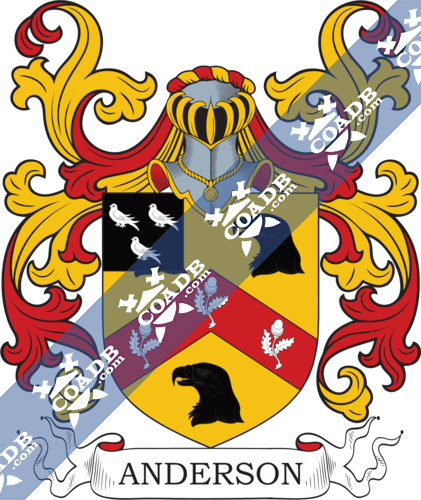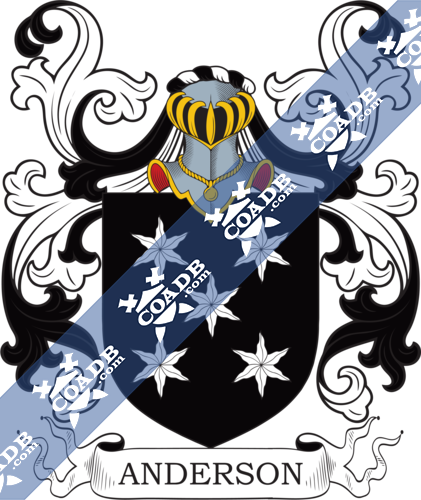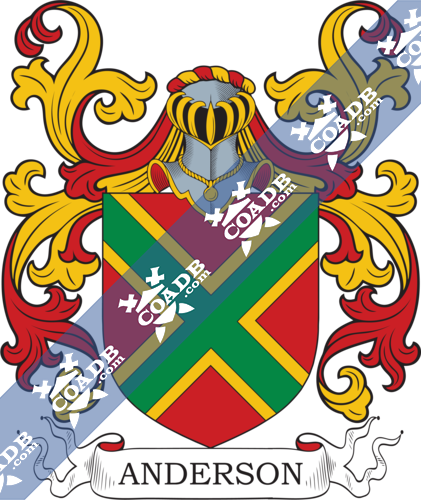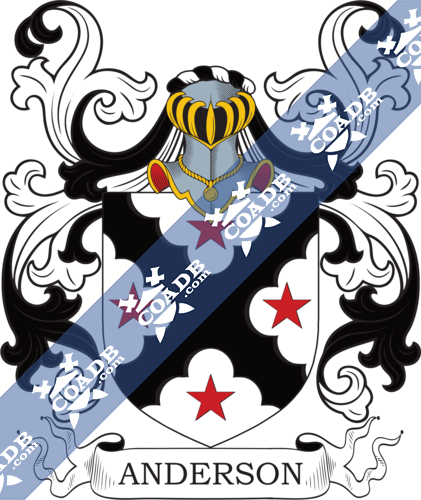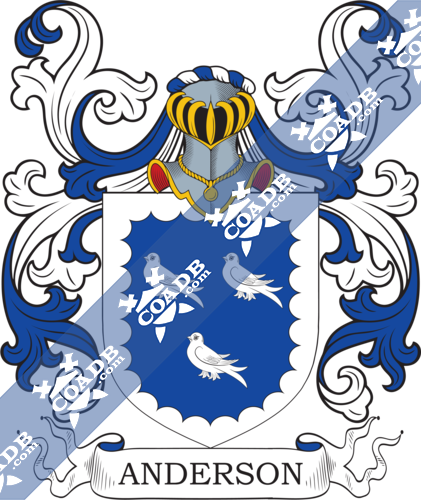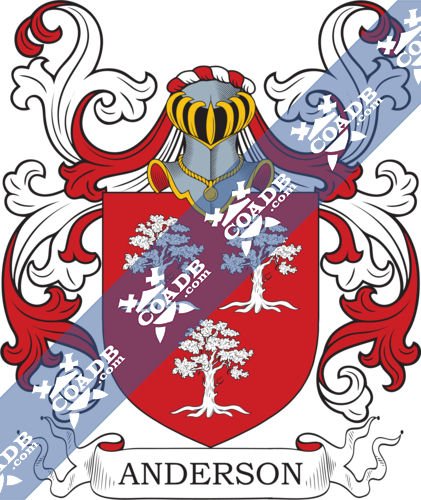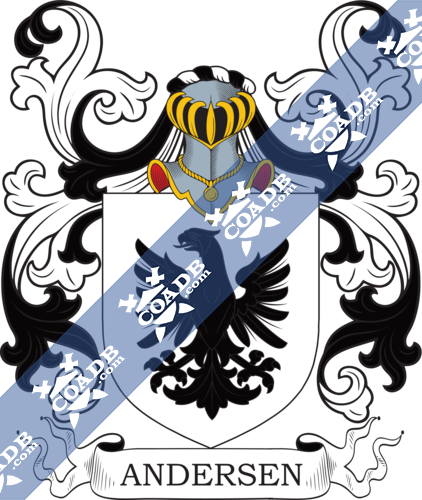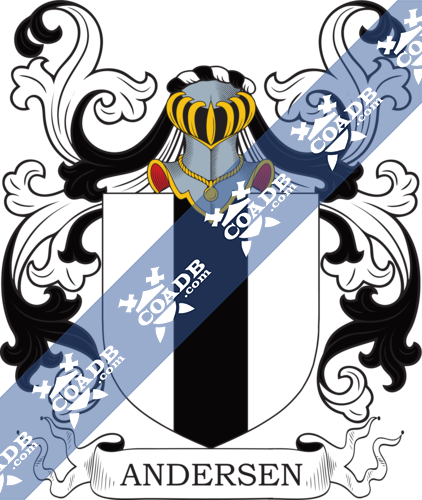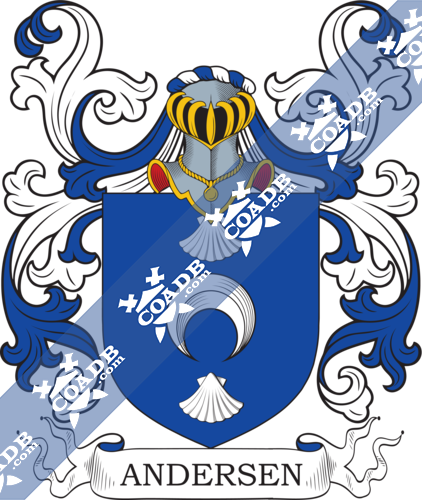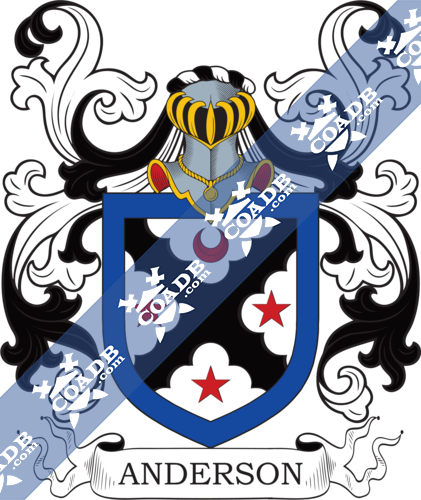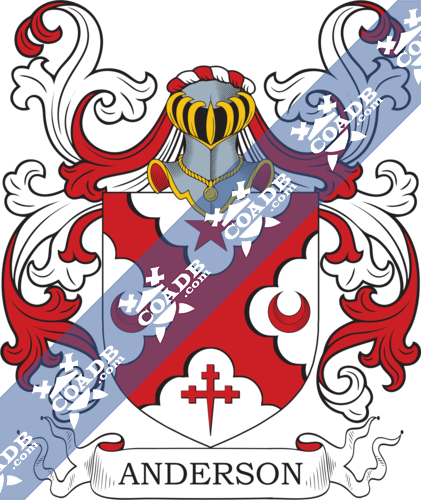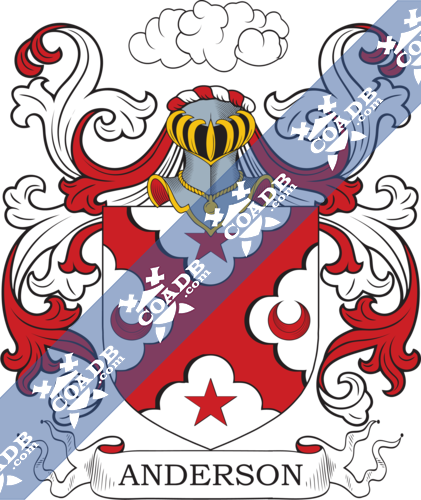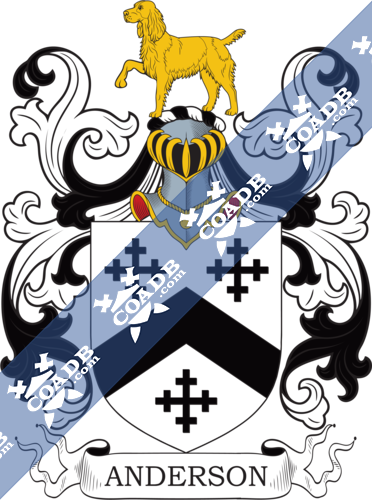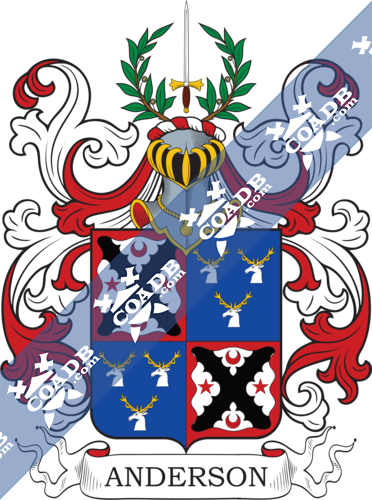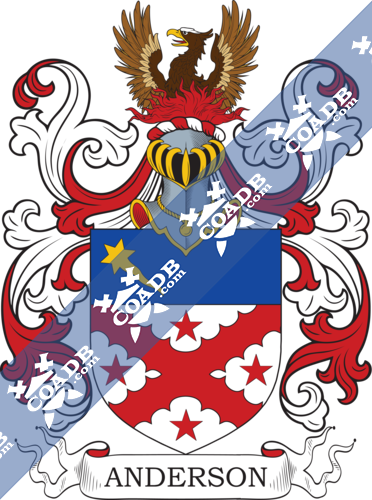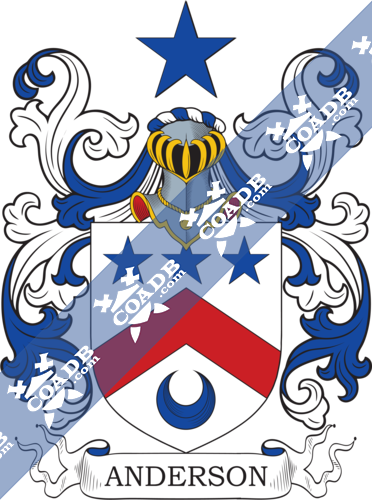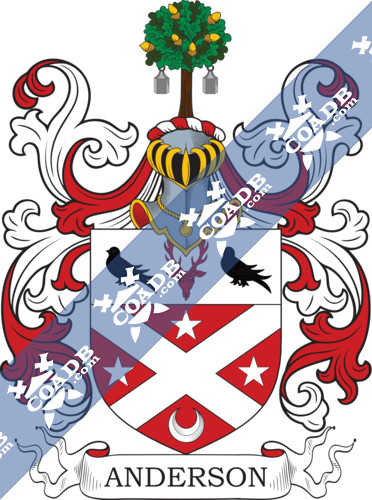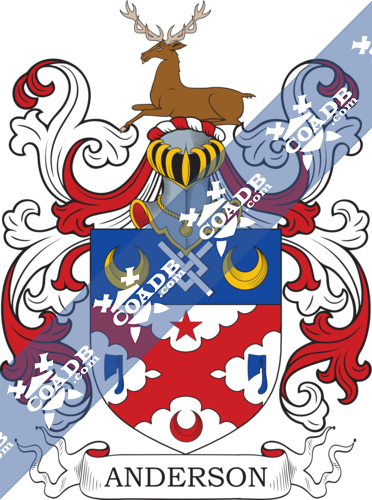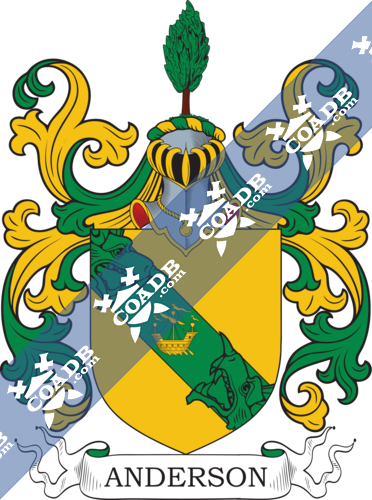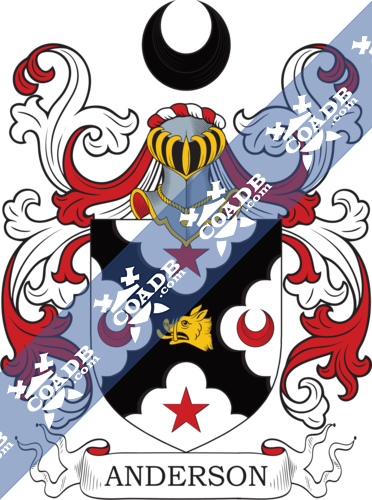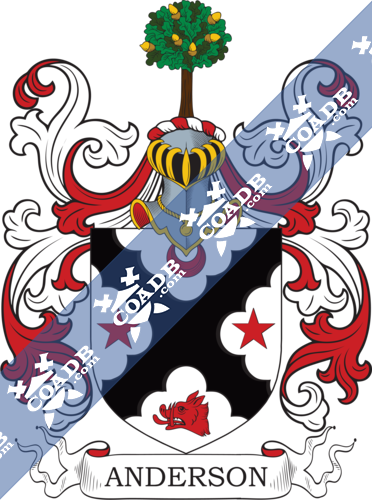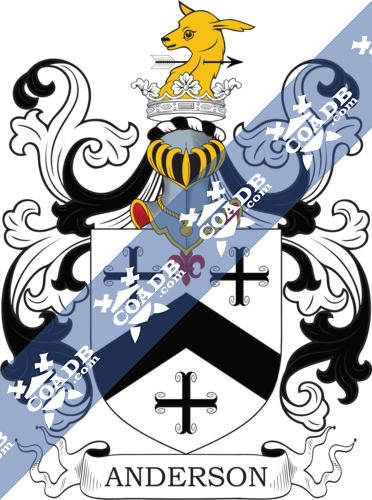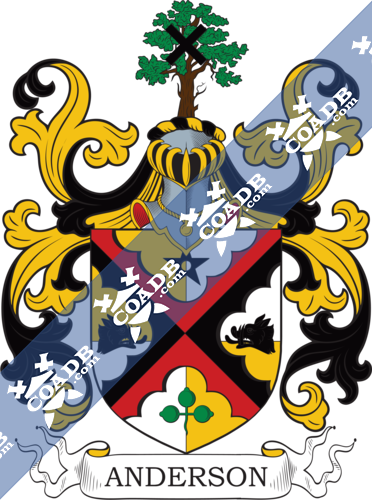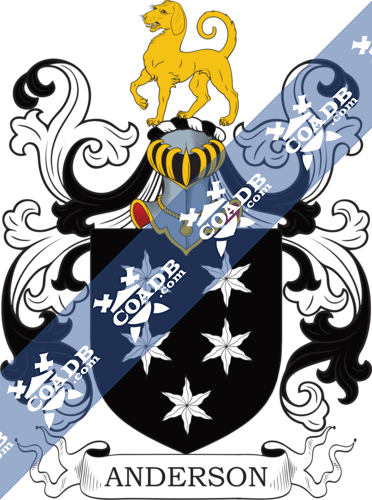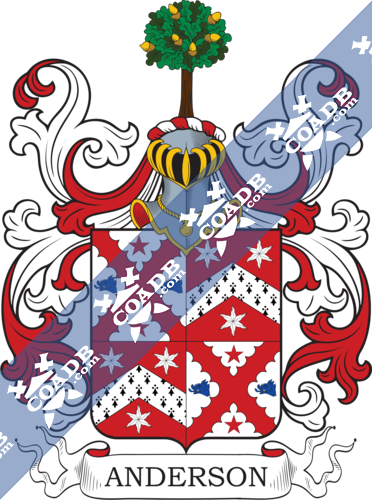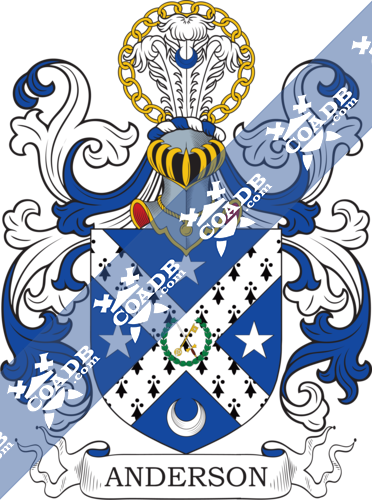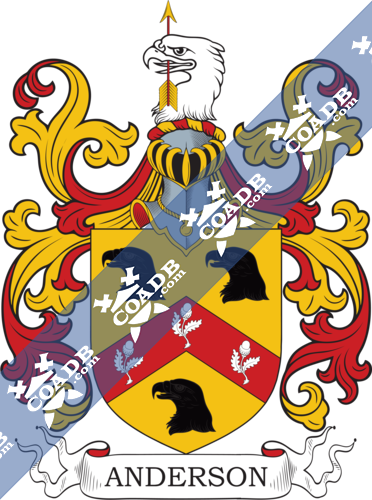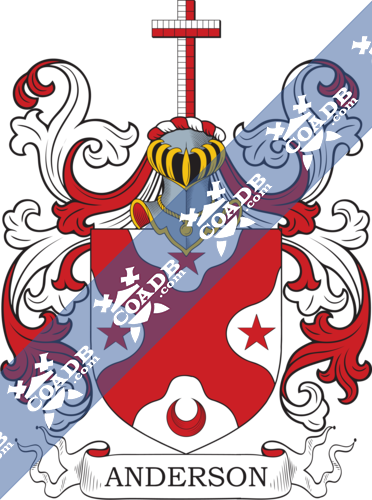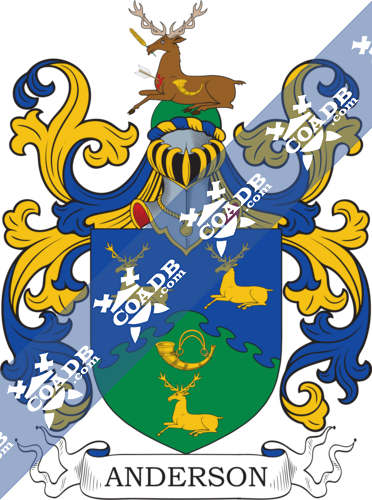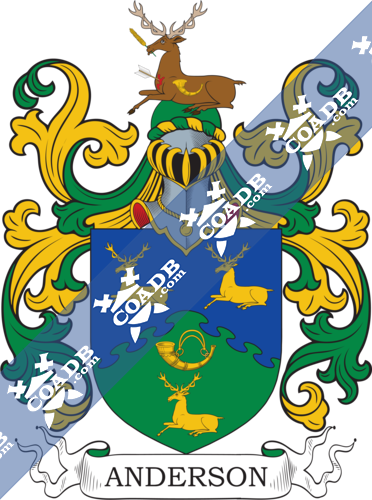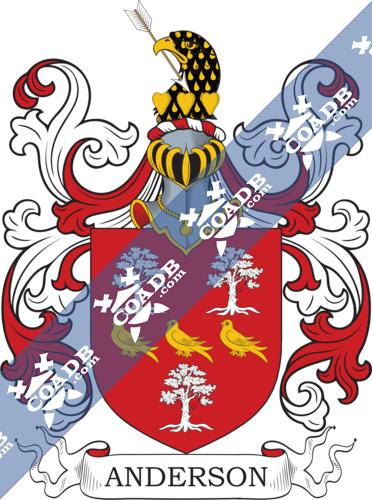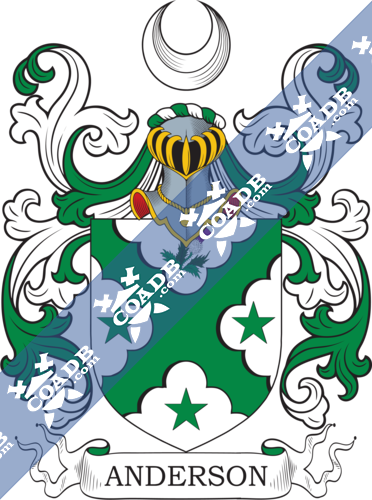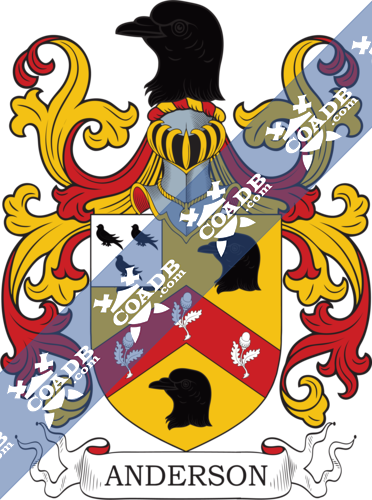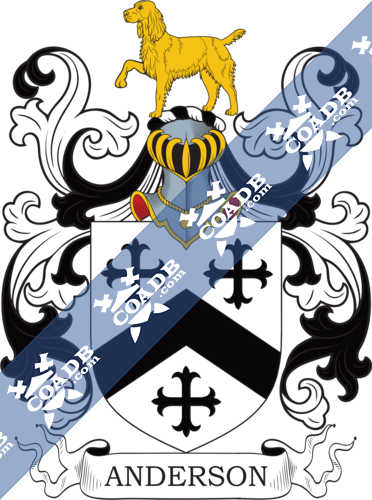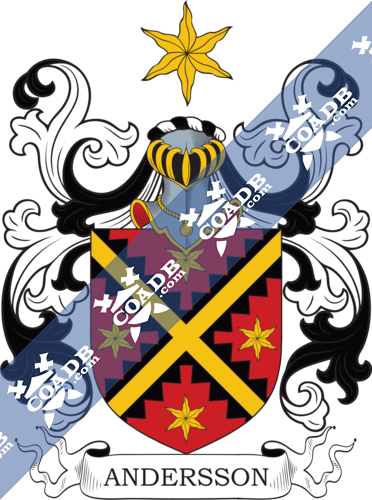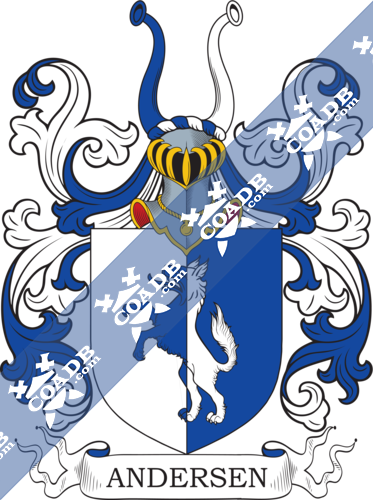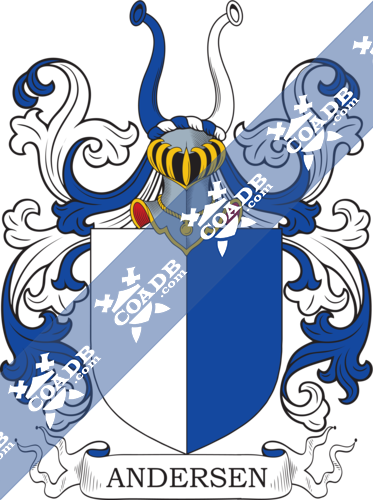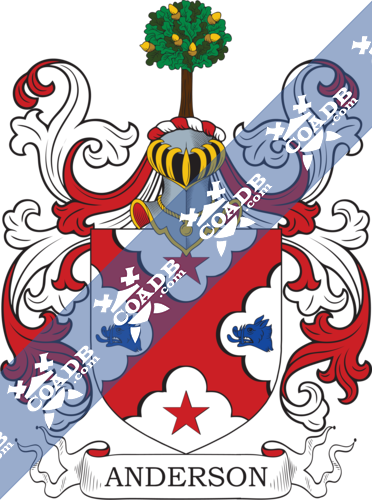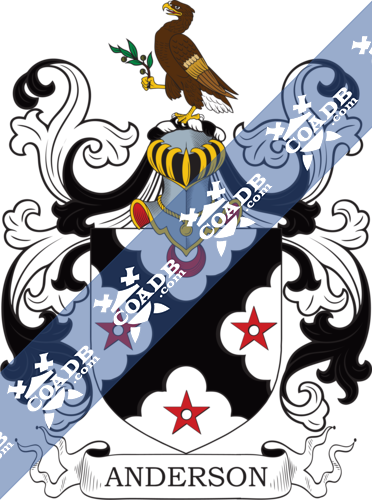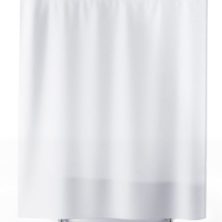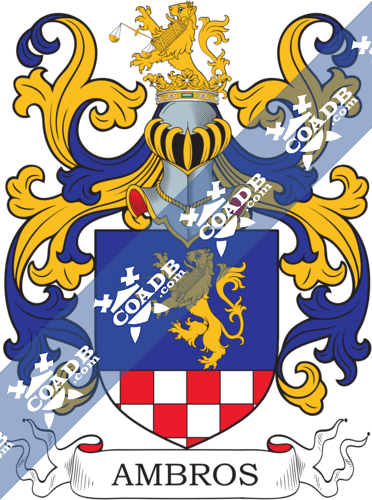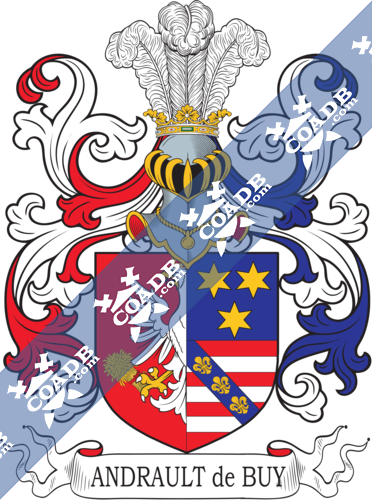Anderson Family Crest, Coat of Arms and Name History
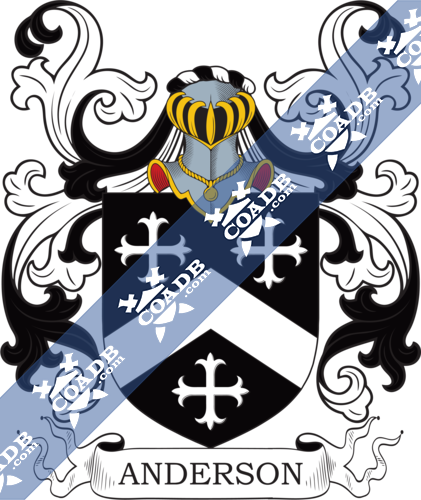
Anderson Coat of Arms Gallery
Don’t know which Coat of Arms is yours?
We can do a genealogical research. Find out the exact history of your family!
Learn MoreMeaning, Origin, Etymology
This very popular Scottish and English surname name is a baptismal or patronymic surname meaning “the son of Andrew” or “the son of Anders”, deriving from the old personal (first) biblical name Andrew, which was popularized throughout the country due to the fact that St. Andrew (who lived in the Roman Empire in the 1st century AD) was the patron saint of Scotland. Andrew derived from the Greek name “Andreas”, meaning “man” or “manly”). It originated in parallel in the British Isles and the Nordic countries. Andrew was one the twelve disciples of Jesus Christ in the Christian religion. In Greek, it derives from the word andreios, meaning masculine, manly, or courageous. In the United States, this name has absorbed many cognate or similar sounding names from other European language, such as the Swedish Anderrson and the Norwegian/Danish Andersen. Due to Americanization the second s was often dropped out of names after immigrating. One source states the family lived among the Dalriadan clans. In Scotland, the family owned land in Moidart, but moved to Badenoch in the early 1300s AD. The most eminent branches established themselves in Dowhills, West Ardbreck, and Candacraigs in Strathdon. The surname Anderson was first found in Schleswig-Holstein and Denmark, where the family contributed greatly to the development of an emerging nation and would later play a large role in the political conflicts of the area. From early on, the name was represented by predominantly Danish families, although most of the Schleswig branches and many of the southern Danish branches spoke German. The first reference to the given name Andrew was a monk of Dunfermline, who later became the Bishop of Caithness in the reign of David I. The first references to the surname appeared in the 13th century. In 1296, David le fiz Andreu was recorded as a burgess of Peebles, and Duncan fiz Andreu of Dumfries was recorded as taking an oath of fealty. The Andersons held territories in Moidart, but later moved to Badenoch in the early 14th century. The most prominent branches of the Andersons were the Dowhills, West Ardbrecks and Candacraigs in Strathdon. Andersons have been involved in a number of record-breaking crimes. George ‘Dutch’ Anderson pulled off a 1921 mail van stick-up which yielded over £500,000; Charlie Anderson took part in the first Wild West train robbery (1866); and ‘Boston Pete’ Anderson successfully talked a reclusive miser out of £850,000 in 1866 and sensibly retired. The Anderson Shelter, invented by one-time British Chancellor of the Exchequer John Anderson, was a simple affair which could easily be installed (as over 3 million were) in a back garden. It saved countless lives during World War II air raids. Andersonville Prison in Sumter County, Georgia, was notorious during America’s Civil War. In the two years of its existence (1864—5) this log stockade of at most 26 acres housed over 32,000 Northern prisoners, half of whom died. There are towns called Anderson in the United Kingdom, Argentina and the United States, rivers of this name in Canada and the United States, and islands so named in Canada and Australia.
Spelling Variations
Andersen, Anderson, Andersone, Andersonne, Andersoun, Andersoune, Andersson, Andirsoone, Andirsoune, Andirston, Andison, Andreson, Andresoun, Andrewson, Androson,
Androsone, Androsoune, Andrson, Andyrson, Endherson, Endirsone, Andreu, MacGhilleAndrais
Early Marriage Records for Anderson
David Anderson married Hannah Philips January 5, 1699 in Boston, Massachusetts
George Anderson married Elizabeth Stevenson June 26, 1693 in New York
William Andersen married Deborah Lyndell October 7, 1697 in New York
Henricus Anderson married Elizabetham Holyman February 10, 1550 in Saint Marys, Hanley Castle, Worchester, England
John Anderson married Margaret Funtstone January 22, 1550 in Saint Stephan Coleman Street, London, England
Thomas Anderson married Francis Huntington November 5, 1610 in Pocklington, York, England
Agnes Anderson married Richard Dobson November 30, 1598 in Spilsby, Lincoln, England
Elizabeth Anderson married John Pagg June 9, 1595 in Rye, Sussex, England
Thomas Anderson married Elizabeth Butler May 13, 1610 in Waltham, Lincoln, England
William Anderson married Dorothy Brisse 1600 in Edlington, Lincoln, England
George Anderson married Hester Bacheler 1591 in Rickmansworth, Hertford, England
Thomas Anderson married Francis Huntington November 5, 1610 in Pocklington, York, England
Anne Anderson married William Davison July 1607 in Ryton, Durham, England
Isabell Anderson married Willyam Couertaye April 27, 1609 in Bourne, Lincoln, England
William Anderson married Elsabethe Darnell November 30, 1608 in Revesby, Lincoln, England
Fraunces Anderson married Robert Needam June 12, 1606 in Saint Mary The Virgin Aldermanbury, London, England
Agnes Anderson married George Clarckson January 29, 1592 in Saint Nicholas Parish Reg and Nonconf, Newcastle Upon Tyne, Northumberland, England
Popularity & Geographic Distribution
The last name Anderson ranks 365thin popularity worldwide as of the 2014 Census and approximately 1,392,936 people carry the Anderson surname worldwide. The name ranks particularly high in the following six states: California, Texas, Minnesota, Illinois, Georgia, and Florida. It ranks highest in the following countries: United States (1,006,306), England (75,260), Canada (70,382), Australia (62,882), Scotland (34,553), and South Africa (25,792).
Early Bearers of Surname
Henry Androsoun, about 1443 in Cupar-Angus Rental Book
John Andrewson, 1444 in Cupar-Angus Rental Book
Robert Androwson, Androson, 1455, 1482 in York Guild Register
Thomas Anderson, 1471 in York Freeman’s Register
Henry Anderson, 1540 in IGI (Cambridge, Cambs)
Margaret Anderson, 1541 in IGI (Durham, Durham)
Edward Anderson, 1542 in IGI (Thuxton, Norfolk)
George Anderson, 1544 in IGI (Merstham, Surrey)
Wylliam Anderson, 1544 in IGI (Rye, Sussex)
Cisly Anderson, 1545 in IGI (Cambridge, Cambs)
Bartholomei Anderson, 1554 in IGI (Howden, ER Yorks)
Robert Annerson, 1739 in IGI (Sunderland, Durham)
Anders Andersson born in Gothenburg, Sweden in Census 1881 (Middx)
Olaf Victor Andersson born in Lysekilt, Sweden in Census 1881 (Durham)
Adam Andersen 1650 in IGI (Dunfermline, Fife)
Alexander Andersen 1651 in IGI (Leuchars, Midlothian)
James Andersen 1756 in IGI (Newcastle upon Tyne, Northumberland)
Ellen Andersen 1821 in IGI (Overton, Hants)
Jens Andersen born in Denmark in Census 1881 (Cornwall)
Olaf Emil Andersen born in Norway in Census 1881 (Durham)
Rogerus Andreweson, 1379: Poll Tax of Yorkshire.
Martin Aunderson, 1495, Yorkshire: Corpus Christi Guild (Surtees Society).
Richard Anderson and Elizabeth Hawkins: 1611 Marriage Lic. (London).
Frederick Anders and Mary Harper: 1769 St. George, Hanover Square.
History, Genealogy & Ancestry
ANDERSON OF GRACE DIEU
Anderson, Thomas-William, Esq. of Grace Dieu, co. Waterford, born 26 June 1852; succeeded his father 22 October 1867. Lineage~ Alexander Anderson, Esq. of Grace Dieu, descended, it is stated, from Anderson, of Wester-Airderbeck, was nephew of the Rev. Arthur Anderson, Chaplain to William III., and of Major Anderson, of Grace Dieu. He married 2 Feb. 1721, Miss Brewster, daughter and co-heir of William Brewster, Esq., son of Sir Francis Brewster, twice Lord Mayor of Dublin. By her (who died 1754) Mr. Anderson left (with two daughters, of whom the elder Jane married Robert Carew, Esq. of Woodenstown, co. Tipperary) a son and heir, James Anderson, Esq. of Grace Dieu married 1764, Susanna, youngest daughter of Chrismas Paul, Esq., by Ellen his wife, daughter of Robert Carew, Esq., M.P., of Castle Boro, co. Wexford, and had issue, 1) James his heir 2) Paul, C.B., K.C., General, Colonel of the 78th Highlanders, and sometime Governor of Pendennis Castle, born 29 March 1767; died without issue at Bath, 1851. 3) Alexander, Capt. in the army; died without issue at Bath, 1833. 4) Henry R.N. died without issue. 5) Joshua (Rev.) who eventually carried on the family. 6) Robert an officer in the 42nd regt., who was killed at the Battle of Alexandria. s.p. 7) Ellen died without issue. The eldest son, James Anderson, Esq. of Grace Dieu, died in London 1838, without issue, and left his estates to his brother. 2) The Rev. Joshua Anderson, A.M., of Grace Dieu, Rector of Myshall, co. Carlow, born 8 December 1770; married October 1807, Anne, eldest daughter of Capt. William Perceval and by her who died 24 March 1854, left at his decease, 6 April 1859 and had issue. i) James his heir ii) William married 24 August 1859, Elizabeth-Paul, 3rd daughter of Samuel-Wallis Adams, Esq. J.P. of Kilbree, co. Cork and has issue, Joshua-Alexander born 19 January 1867; and Wilhelmina-Elizabeth. iii) Robert-Carew, M.D., Deputy Inspector of Hospitals, formerly Surgeon-Major in the 13th Light Dragoons, married 13 Oct. 1853, Jane-Wallis, only daughter of the Rev. Henry Bolton, A.M., vicar of Drart, Enos. Queens Co. and has issue a) Robert-Henry born 17 Aug. 1854 b) Charles-Alexander born 10 Feb. 1857; c) William-Paul born 16 June 1858. d) Francis-James born 17 Feb. 1860. e) Joshua-Perceval born 4 May 1863. f) Frances-Ann-Grace g) Catherine-Jane-Henrietta. iv) Paul-Christmas of Prospect, co. Kilkenny. v) Alexander, R.N. Commander of H.M.S. “Cressy” died on board his ship in the Baltie, and was buried on the Island of Nargen Aug. 1854. vi) Anne married 4 fe. 1845, to Charles-Newport Bolton, Esq., B.A., of Brook Lodge, co. Waterford. vii) Jane-Elen viii) Ellen married 13 Dec. 1859 to George-Bevan Russell, Esq., M.D. iX) Catherine died 18 Feb. 1855 x) Henrietta xi) Susanna. Mr. Anderson died 6 April 1859, and was succeeded by his eldest son, James Anderson, Esq. of Grace Dieu, J.P., born 4 Aug. 1810; married 25 April, 1842, Margaret, youngest daughter of Thomas Carew, Esq., J.P., of Ballinamona Park, by his wife, Jane, eldest daughter and co-heir of Sir John Alcock, of Waterford by whom, who died 29 Feb. 1864 he had issue, 1) James-Paul born 21 Jan. 1850; died 26 sept. 1860. 2) Thomas-William his heir. 3) Alexander-Carew born 6 May 1856. 4) Jane-Margaret married 15 Dec. 1868 to Capt. Michael-Clare Garcia, and has three sons, Clare-James born 30 Nov. 1869; Herbert-George-Anderson born 5 Feb. 1871; Harry-Carew born 9 Feb. 1875. Mr. Anderson died 22 Oct. 1867. Seat~ Grace Dieu Lodge, Waterford.
ANDERSON OF LITTLE HARLE TOWER.
Anderson, George, Esq., of Little Harle Tower, Northumberland, M.A., J.P., Barrister-at-Law, born 16 Aug. 1843; succeeded 1872. Lineage~ This family was resident at Long Cowton in Yorkshire, A.D. 1666, previously at Newcastle-on-Tyne and Great Haswell Grange, co. Durham. Thomas Anderson, Esq., who married 5 June 1806, Ann Bell, and died 9 Sept. 1821, leaving a son, Thomas Anderson, Esq., J.P. and D.L., who purchased Little Harle Tower from the family of Murray-Aynsley. He married 20 April 1841, Emily, dau. of Rev. John Fisher, of Wavendon and by her (who died 20 Dec. 1877) had issue, George, now of Little Harle Tower; John; Mary; Eleanor; Mabel. Mr. Anderson died 28 October 1872. Seat~ Little Harle Tower, Newcastle-on-Tyne.
ANDERSON OF HARROLD PRIORY
Sir John Anderson, 1st Baronet, was of Harrold Priory in county Bedford, England who was born in 1878 and became a Justice of the Peace for the city and county of Glasgow, Scotland. He was created a baronet in 1920. In 1911, he married Jessie Barr, daughter of Alexander Bilsland of Woodside Terrace. In 1941, he married Muriel Stanley-Wiggins of Satra, Shoreham-by-Sea, daughter of J.E. Franklin of Kemp Town. The lineage of this family traces back to John Anderson of Auchterarder Perthshire who died in 1889 and left a son named Peter. This Peter was of Marchcroft, Maxwell Park, Glasgow and of Westerlea, Auchterarder, Pertshire who was a Justice of the Peace born in 1847. In 1875, he married Margaret, daughter of William MacIntosh of Gateside, and issue with her, including a son named John, the 1st Baronet mentioned at the beginning of this paragraph. The Anderson Coat of Arms (erroneously called the Anderson Family Crest) is blazoned in heraldry as follows: Per fesse argent and or, in chief two saltires couped and in base a boar’s head erased gules. Crest: In front of an oak tree fructed proper, two saltires or. They resided as Astra Lea, Crowborough, Sussex.
ANDERSON OF JESMOND HOUSE
Anderson, Thomas, Esq. of Jesmond House, co. Northumberland, and Wallington Lodge, co. Surrey. born 21 Sept. 1789; married 7 June 1827, Isabella the daughter of Robert Simpson, M.D. of St. Petersubrgh, formerly of Sebrigham Hall, Cumberland and has issue 1) John-Soulrby born 22 June 1828 2) Robert-Gerarad born 9 June 1830 3) Thomas-Goldsborough born 5 April 1833 4) Charles-King b. 24 Aug. 1836 Mr. Anderson succeeded his father 1829 and served as sheriff of Newcastle in 1812. Lineage~This family settled in Newcastle from the time of Elizabeth, until about the year 1620, when they removed to North Shields, where they held property, a portion of which still continues in possession of the family. About the middle of the last century they returned to Newcastle. Gerard Anderson born in 1646 married Elizabeth Nicholson and died in 1711 leaving with a daughter Barbara married to Capt. Valentine Wye a son, Thomas Anderson born in 1710 who married 27 Sept. 1736 Eleanor Soulsby of Newcastle and had with two daughters, three sons, 1) Thomas who died unmarried in 1789. 2) Matthew born in 1754 who settled in St. Petersburg about the end of the last century; and died in 1834, leaving issue three sons Thomas born at St. Petersburg 1793; John married Frances daughter of Robert Simpson, M.D. and has issue Robert-Alexis married Harriet daughter of Robert Cattley, Esq., Thomas-Gerard and other children; Matthew married Annie-Elizabeth Maine, and has issue; Eleanor married to Joseph Stother, Esq.; 3) John of whom we treat. John Anderson, Esq. of Jesmond House, J.P., born 1 Nov. 1757; married 12 May 1787, Hannah daughter of James King, Esq. of Newcastle and had issue, 1) Thomas now of Jesmond House 2) Matthew of Jesmond Cottage, J.P. born 18 April 1792. 3) James-Crosby of Little Benton married in 1822, Alice daughter of William Losh, Esq. of Point Pleasant, and died in 1837, leaving issue, John born 2 Feb. 1826; William Losh, born 16 Jul 1826; James-Crosby, born 12 Jul 1828; Alice; Eleanor-Adelaide. John, of Coxlodge Hall, Northumberland, J.P., sheriff of Newcastle 1820; married in 1827, Dorothy-Diana, daughter of Charles-Dalston Purvis, and sister of Thomas Purvis, Esq., Q.C. and has issue Charles Dalston born 16 Mar 1836; Dorothy-Elizabeth; Hannah-Emily married 3 May 1851 to W.F. Carter, Esq, capt. 63rd regt; Marianne-Purvis; Eleanor; and Florence. Mr. Anderson died 6 May 1829. Arms~ Per nebulee az. and vert., a bugle horn stringed, between three stags, couchant, or. Crest~ On a mount, vert, a stag couchant, wounded in the breast by an arrow, and holding in his mouth an oar of wheat, all ppr., charged on his side with a bugle horn, or. Motto~ Nil desperandum, auspice Deo. Seats~ Jesmond House, co. Northumberland; and Wallington Lodge, Surrey.
DOD’S PEERAGE, BARONETS, KNIGHTS, BISHOPS, PRIVY COUNCILLORS, ETC.
ANDERSON, Bishop.—Right Rev. David. Anderson, D.D., eldest son of Capt. Archibald Anderson, of the E.I.C.S. Born 1814; mar. 1841, eldest dau. of James Marsden, Esq., of Liverpool (she died 1847) ; was formerly scholar of Exeter College, Oxford, Where he graduated B.A. 1836, M.A. 1839, and D.D. 1849; Avas ordained in 1837, and consecrated in 1849 ; was previously vice-principal of St. Bees’ Clerical College, and perpetual curate of All Saints’ Church, Derby ; was consecrated 1st Bishop of Rupert’s Land 1849; resigned that see 1864; appointed incumbent of Clifton 1864.
ANDERSON, Knt. Bachel. Great. 1863. — Sir Alexander Anderson, son of the Rev. William Anderson, minister of Strichen, Aberdeenshire, by the dau. of Dr. Alexander Findlay, surgeon R.N, Born at Strichen, Aberdeenshire, 1802; mar. 1835, dau. of Richard Johnstone, Esq., of Viewfield, Aberdeenshite. Educated at the parish school of Strichen, at Marischal College, and the University of Aberdeen ; became an advocate in Aberdeen in 1827 ; has been lord provost of that city since 1859 ; is a deputy-lieut. for the CO. ; knighted after the inauguration of a memorial statue to the late Prince Consort at Aberdeen, Oct. 1863. Residences— Union Street, Aberdeen ; Blelach, near Taiiand, Aberdeenshire.
ANDERSON, 9th Bart. (Eng.) Great. 1660. — Sir Charles Henry John Anderson, son of the 8th Bart., by the 2nd dau. of Sir John Nelthofpe, Bart, (she died 1836.) Born at Lea Hall 1804 ; mar. 1832, dau. of the late John Saville Foljambe, Esq., of Aldwarke, Yorkshire ; succeeded his father in 1846 ; educated at Oriel College, Oxford, where he graduated B.A. 1826, M.A. 1829; admitted atif eundem at Cambridge 1854; is patron of 1 living; appointed sheriff of Lincolnshire 1851. Seat—Lea Hall, Gainsborough, Lincolnshire. Heir, his son Francis Foljambe, born at Lea Hall 1841.
ANDERSON, Lady (Knt.’s widow) Janet, only dau. of Robert Hood, Esq., of Glasgow. Mar. 1841 Sir James Anderson, lord provost of Glasgow, who was knighted on the Queen’s visit to Glasgow in Aug. 1849, and died 1864.
ANDERSON, Lady (Knt.’s widow). — Jane, dau. of the late Archibald Wight, Esq., of Ormiston, East Lothian. Mar. 1833 (as his second wife) Sir George William Anderson, K.C.B., who was knighted 1849, and died 1857. Residence —Q9, Westbourne Terrace, London, W.
OTHER ANDERSON PEDIGREE AND FAMILY TREES
William Anderson was born in Accomach, colonial Virginia in 1600 AD. He married Mary Wise and had a daughter with her named Comfort. Comfort was born in Maryland in 1625 and she married George Taylor IV.
John Anderson was born in Ireland around 1704 and he came to colonial America, passing away in Orange, North Carolina. He had two sons: William and James. His son James was born in Lancaster, Pennsylvania in 1731 and he married Elizabeth Mebane and had the following children with her: Ann, Reverend Alexander, Jane, Thomas, and Margaret. He was a soldier in the American Revolution. His son Reverend Alexander Anderson was born in North Carolina in 1764. He married Phoebe Hall and had the following children with her: Ann (Bull), William C., Jane, Thomas, and Margaret. His won William C. was born in Orange County, NC in 1771.
THE COUNTY FAMILIES OF THE UNITED KINGDOM OR ROYAL MANUAL OF THE TITLED AND UNTITLED ARISTOCRACY OF GREAT BRITAIN & IRELAND
ANDERSON, Sir Charles Henry John, Bart., of Lea, Lincolnshire (cr.1660). Eldest son of the late Sir Charles John Anderson, Bart., of Lea Hall, by Frances Mary, daughter of the late Sir John Nelthorpe, Bart., of Scawby; born 1804; succeeded as 10th Bart. 1846; married 1832 Emma the daughter of the late John Saville Foljambe, Esq., of Aldwarke, Notts. Educated at Oriel Coll., Oxford (B.A. 1826, M.A. 1828); is a Magistrate for the W. Riding of Yorkshire, and J.P. and D.L. for co. Lincoln (parts of Lindsey), and Chairman of the Quarter Sessions; is Patron of 1 living; was High Sheriff of co. Lincoln 1851. This family is descended from Roger Anderson de Wrawby, temp. Edward IV., and said to be Danish extraction. Lea Hall, near Gainsborough, Lincolnshire; Athenaeum Club, S.W. Heir, his son Francis Foljambe, born 1842; educated at Eton.
ANDERSON, Sir James, Knight of Blairyadoch, Dumbartonshire (c. 1849). Son of the late John Anderson, Esq., merchant, of Stirling; born 1800 married 1831 Janet, only daughter of Robert Hood, Esq., of Glasgow; is a Magistrate for co. Dumbarton, and a Manufacturer at Glasgow, of which city he was Lord Provost in 1849; was M.P. for the Stirling boroughs 1852-9. Blairvadoch, Dumbartonshire; 3, Blythwood Square, Glasgow; Reform Club, S.W.; 48, Pall Mall, S.W.
ANDERSON, Lady of Cromall Lodge, Argyllsire. Jane daughter of the late Archibald Wright, Esq., of Ormiston, co. Haddington; married 1833 (as 2nd wife) Sir George William Anderson, K.C.B., who died 1857. Cromall Lodge, Campelltown, Argyllshire; 99, Westbourne Terrace, W.
ANDERSON, Alexander John, Esq., of Kingask, Fifeshire. Eldest son of the late Major Alexander Anderson (of the E.I. Co.’s service, a Dep. Lieut. for co. Fife), by Mary Margaret, eldest daughter of J.H. Hampton, Esq., of Heallys, Anglesey; born 1827; succeeded 1855. Is a Capt. in Her Majesty’s Indian Army. Kingask, near Montrave, Fifeshire.
ANDERSON, Arthur, Esq., F.S.A., of Norwood, Surrey. Son of the late Mr. Robert Anderson, of Lerwick, Shetland; born 1792; married 1822 Mary Ann, daughter of the late Christopher Hill, Esq., of Scarborough. Is Chairman, senior Managing Director, and one of the founders of the Peninsular and Oriental Steam Navigation Company; Chairman of the Union Steamship Company and of the General Association of Steamship Owners; a Director and lately Chairman of the Crystal Palace; and was M.P. for Orkeny and Shetland 1847-52. Norwood Grove, Surey, S.; Reform Club, S.W.
ANDERSON, David, Esq., of St. Germains, Haddingtonshire. Eldest son of the late David Anderson, Esq., by Christina, daughter of the Rev. Robert Findlay of Drunmore, Mid-Lothian; born 1791 succeeded 1825; married 1828 Charlotte daughter of Sir James Nasmyth, Bart., of Posso, and has, with other issue, James Warren Hastings, Capt. in the 87th Royal Irish Fusiliers born 1836. Mr. Anderson, who was educated at the High School and University of Edinburgh, and Ch. Ch., Oxford, and called to the Scottish Bar 1814, is J.P. and D.L. for co, Haddington. St. Germains, near Long Niddry, Haddingtonshire, N.B.; New Club, Edinburgh; Union Club, S.W.
ANDERSON, George, Esq., of Woodhouse, Dumfriesshire. son of the late Rev. Anderson; born 18?; educated at the University of Aberdeen; was formerly Surgeon in H.M.’s forces, and is now Staff Surgeon Major, Woodhouse, near Ecclefechan, N.B.; United Service Club, Edinburgh.
ANDERSON, James, Esq. of Grace Dieu, co. Waterford. Eldest son of the late Rev. Joshua Anderson (many years Rector and Vicar of Myshall, co. Carlow), by Anne, eldest daughter of Capt. William Perceval; born 1810; succeeded 1859; married 1842 Margaret, daughter of Thomas Carew, Esq. of Ballinamona Park, co. Waterford, and has, with other issue, Thomas William born 1853. Mr. Anderson who was educated at Trinity Coll., Dublin is a Magistrate for co. Waterford. This family formerly settled at Wester Eyre, Derbeck in Scotland, came to Ireland temp. William III. Grace Dieu, near Waterford.
ANDERSON, Thomas, Esq. of Little Harle Tower, Northumberland. Son of the late John Anderson, Esq., of Jesmond, J.P., by Hannah, daughter of Mr. King; born 179? married 182? Miss Simson, of St. Petersburg, and has, with other issue, John born 182?. Mr. Anderson is a J.P. and D.L. for Northumberland (of which county he has been High Sheriff). This family were formerly of Jesmond House, in the same county. Little Harle Tower, near Newcastle-on-Tyne.
ANDERSON, the Rev. Thomas, of Felsham, Suffolk. Eldest son of the late – Anderson, Esq. of N.B.; born 1794; married 1822 Mary the daughter of Mr. Campbell, Esq. who died 185?, leaving, with other issue, James Richard, Rector of Town Barmington; born 1824; married 1847 Elizabeth Julia, eldest daughter of the Hon. and Rev. Edward Pellew, and granddaughter of the 1st viscount Exmouth, G.C.B. Mr. Anderson, who was educated at Exeter Coll., Oxford (B.A. 1816, M.A. 1819), is a Magistrate for Suffolk, and Chairman of the Bury St. Edmund’s Quarter and Petty Sessions; Rector and Lord of the Manor of Felsham, and Patron of that living. This family is of Scottish extraction. Felsham Rectory, near Woolpit, Suffolk.
DICTIONARY OF NATIONAL BIOGRAPHY, VOLUMES 1-20, 22
ANDERSON, ALEXANDER (1582-1619), mathematician, was a native of Aberdeen. Little is certainly known about him; but the year 1582 is assigned as that of his birth on the authority of a print representing him in 1617 as of the age of thirty-five. He taught mathematics in Paris early in the seventeenth century, and appears to have been a friend of Vieta, who died in 1603, and whose posthumous writings he edited with great ability, developing much that was only indicated, and demonstrating much that was barely stated. He alludes more than once to the poverty of his circumstances; abstruse studies and the neglect of common and easy life brought him, he tells us, more wisdom than riches (Vindiciae Archimedis, Dedication). He is not heard of after 1619, the date of his last publication, and is accordingly believed to have died about that time. The celebrated James Gregory was, on the mother’s side, connected with his family. A couple of his works are: 1. ‘Supplementum Apollonii Redivivi,’ Paris, 1612, in which he displays a remarkable command of the ancient analysis and supplies the deficiencies in Ghetaldi attempted restoration of the lost book of Apollonius. 2. ‘Francisci Vietae de Equationum recognitione et emendatione tractatus duo,’ Paris 1615, contain Vieta’s improvements in the transformation and reduction of algebraical equations, with an appendix by Anderson, showing that the solution of cubic equations can be made to depend upon the trisection of an angle.
ANDERSON, SIR EDMUND (1580-1605), lord chief justice of the court of Common Pleas, was descended from a Scotch family which, after a long settlement in Northumberland, migrated to Lincolnshire, and was born in 1530 at Flixborough or Broughton, in the latter county. After spending a short time at Lincoln College, Oxford, Anderson became in June 1550 a student of the Inner Temple, and ‘by indefatigable study’, says Anthony a Wood, ‘obtained great knowledge of laws.’ In 1567 he was appointed both Lent and Summer ‘reader’ at his inn of court, and a reference to him in Plowden’s reports of the chief contemporary cases proves him to have acquired a considerable practice before 1571. Three years later he was nominated ‘double reader’ at the Inner Temple, and in Michaelmas term, 1577, he became a serjeant-at-law. In 1579 he was advanced to the highest dignity attainable at the bar, that of serjeant-at-law to the queen. As an assistant judge on circuit, Anderson began to exercise judicial functions soon after this promotion, and in 1581 he conducted cases of importance in both the eastern and western counties. At Bury, in the Norfolk circuit, Robert Brown, the founder of the sect of Brownists or Independents, was brought before him on a charge of nonconformity, and in sentencing him to a term of imprisonment Anderson emphatically expressed his intention, fully carried out in his subsequent judicial career, of upholding the Establishment against puritan dissent by every means in his power. On the western circuit, in November of the same year, Anderson presided at the trial of Campion and other seminary priests, charged with ‘compassing and imagining the queen’s death’, and here, as in many similar cases with which he was connected, he assumed an attitude of personal hostility to the prisoners. The evidence adduced against Campion and his followers was somewhat slender, but the judge in an introductory speech ‘with grave and austere countenance dismayed the prisoners,’ and secured their conviction by his rhetorical invective. Anderson’s vigorous support of the crown’s authority against its various opponents did not go unrewarded. The Bishop of Norwich requested Lord Burghley to call the queen’s attention to his energy in the conviction of Brown, and the government showed themselves grateful for his action towards the catholic conspirators. Soon after the death of Sir James Dyer, the lord chief justice of the Common Pleas, Anderson was promoted to the vacant office, and he took his seat on the bench on 2 May 1582, receiving at the same time the honour of knighthood. Fleetwood, the recorder of London, in a letter to Lord Burghley describing his investiture, writes in the highest terms of the learning and facility he displayed on that occasion in arguing some very difficult points of law, which were proposed for his decision by leading members of the bar.
Early American Immigration and New World Settlers
Anderson Settlers in United States in the 17th, 18th, 19th & 20th Century
Jochem Anderson, who arrived in New York, NY in 1600
Heinrich Anderson, who immigrated to Philadelphia in 1627
Thomas Anderson, who settled in Virginia in 1634
Joseph Anderson and Richard Anderson in 1635
Jo Anderson, aged 20, who arrived in Virginia in 1635
Hannah Anderson, who arrived in Virginia in 1705
Enoch Anderson, who landed in New Jersey in 1709
Jacob Anderson, who emigrated from England to New England in 1710
Derrick Anderson, who landed in Virginia in 1714
Edward Anderson, who landed in Virginia in 1717
Archd Anderson, aged 19, who arrived in Philadelphia, Pennsylvania in 1803
James Anderson, who arrived in America in 1804
Henry Anderson, aged 46, who arrived in Philadelphia, Pennsylvania in 1804
George Anderson, who landed in America in 1804
Charles Anderson, who landed in America in 1805
Chris Anderson, who landed in Alaska in 1900
Herman Anderson, who landed in Mississippi in 1900
Eliza J Anderson, who landed in Colorado in 1902
Frank Anderson, who arrived in Arkansas in 1903
Chris C Anderson, who arrived in Mississippi in 1903
Anderson Settlers in Canada in the 18th, 19th Century
Edward Anderson, who arrived in Nova Scotia in 1749
James Anderson, who landed in Nova Scotia in 1749
John and William Anderson, who immigrated to Newfoundland in 1763
Elizabeth Anderson, aged 36, who landed in Fort Cumberland, Nova Scotia in 1775
Mr. Alex Anderson U.E., United Empire Loyalist who settled in Home District, South Central Ontario c. 1783
Alexander Anderson and his wife Isobel, who emigrated from Scotland to Charlottetown, Prince Edward Island in 1808 with their children James, Ann, Christina, and Isobel
William Anderson, aged 28, who landed in Canada in 1811
William Anderson, aged 28, who arrived in Canada in 1811
William Anderson, aged 37, a gardener, who arrived in Quebec aboard the ship “Atlas” in 1815
Ann Anderson, aged 36, who arrived in Quebec aboard the ship “Atlas” in 1815
Anderson Settlers in Australia in the 19th Century
Thomas Anderson, English convict from Middlesex, who was transported aboard the “Ann” on August 1809, settling in New South Wales, Australia
Peter Anderson, English convict from Sussex, who was transported aboard the “Asia” on April 1st, 1822, settling in New South Wales, Australia
John Anderson, English convict from Leicester, who was transported aboard the “Asia” on July 29th, 1823, settling in Van Diemen’s Land, Australia
John Anderson, a carpenter, who arrived in Van Diemen’s Land (now Tasmania) sometime between 1825 and 1832
Hugh Anderson, a bricklayer, who arrived in Van Diemen’s Land (now Tasmania) sometime between 1825 and 1832
Anderson Settlers in New Zealand in the 19th Century
Mr. James Anderson, Australian settler travelling from Hobart, Tasmania, Australia aboard the ship “Bee” arriving in New Zealand in 1831 [9]
Mr. Jacob Anderson, Australian settler travelling from Hobart, Tasmania, Australia aboard the ship “Bee” arriving in New Zealand in 1832 [9]
J Anderson, who landed in Hokianga, New Zealand in 1839
Archibald Anderson, who landed in Wellington, New Zealand in 1840 aboard the ship Bengal
Mottoes
Dum spiro spero While I breathe, I hope
Fortiter et recti. Boldly and rightly
Gnaviter. Skilfully.
Gradatim. By degrees.
Honest and fast
Nil conscire sibi To feel no guilt
Nil desperandum auspice Deo. Nothing to bo despaired of under the auspices of God.
Per mare (By sea) Anderson of Aberdeen
Pro Deo certo I strive for God
Pro bello vel pace Prepared in war and in peace
Providentia et industria By arms and industry
Providentia. By providence.
Qui honeste fortiter. He who acts honestly acts bravely.
Recte quod honeste. That is rightly which is honestly done.
Sic viret virtus. So virtue nourishes.
Stand sure
Ubi solum ibi coelum Where there is land there is sky
Vigilans et certus Watchful and faithful
Vigilia Vigilant
Grantees
ANDERSON, Edmond, Erbury, co. Warwick, 4 July 1572, by Cooke. Harl. MS. 1359, fo. 122’’ ; MS. Aslim. 844, fo. 17, copy of grant, Bodleian Lib. ; Grants II., 526, and Guil. 86.
ANDERSON„ Henry, of the towne of Newcastle upon Tyne, gent., 3 Nov. 1547, by G. Dethick, Norr. Harl. MS. 1359, fo. 5*’ ; 1507, fo. 422, copy of grant Brit. Museum ; Q’s Coll. Oxf. MS. 37, fo. 12 ; 39, fo. 9, and Guil. 230 ; Add. MS. 35,336, fo. 7, and V. 0. Grants 45 ; Le Neve’s MS. 432.
ANDERSON, James, of Hollam, Hampsh., and Linlithgow, 26 Jan. 1789,* Vol. XVII, fol. 61.
ANDERSON BEFORE PELHAM. Baron Yarborough [1791], Vol. XVIII, fol. 102.
ANDERSON, Sir John William, Barf., Lord Mayor of London, 17 JI.a3′ 1798, Vol. XX, fol. 118.
ANDERSON„ Andrew, Col. lI.E.I.C.S., 21 Mar. 1808,* Vol. XXIV, fol. 378.
ANDERSON TO SETON, James, LL.D., of Mounie, Aberdeen, and West Ham, co. Essex. Match, 181 . ., V.d. XXVI, fol. 381.
ANDERSON, Major Robert (and his wife Anne, nat. dau. of Wright, impaled), London, and Dunbar, Scotland. Arms of Wright onlv, 181 . .,* Vol. XXVIL fol. 224.
ANDERSON TO BEWICKE, Calverley Bewicke, of Close Hill, co. Northumberland”, 1815, Vol. XXIX, fol. 202″.
ANDERSON, Alexander, Lieut.-Col., C.B., K.T.S., of Portugal, 182 . ., Vol. XXXVI, fol. 327.
ANDERSON„ Matliew, s. of William (M.A., Camb.), of Sonning, co. Berks., and Heme Hill, CO. Kent, 184 . ., Vol. XLVII, fol. 170.
ANDERSON„ Thomas, s. of John, of London, Jasmond, Jesmond House, co. Northumberland, and St. Petersburg, 185 . ., Vol. LI, fol. 92
ANDERSON„ George, of Little Harle Tower, Newcastle-upon-Tyne, co. Northumb., 1883,’ Vol. LXII, fol. 93.
ANDERSON„ James Henry, of Russetings, Bournemouth, Hampsh., 1889,* Vol. LXV, fol. 69.
Notables
Dave Anderson (1929-2018), American sportswriter who won the 1981 Pulitzer Prize for Commentary
David and Alexander Anderson of Finshaugh, who made great contributions in the world of mathematics
Hans Christian Andersen (1805—75) created some of the world’s best-loved fairy tales. America’s Sherwood Anderson (1876— 1941)
Harry Laverne Anderson (1952-2018), American actor, comedian, and magician, best known for his leading role as Judge Harry Stone the television series Night Court (1984-1992)
John Anderson GCB, OM, GCSI, GCIE, PC, PC (Ire), FRS (1882-1958), 1st Viscount Waverley, British civil servant and politician, Chancellor of the Exchequer (1943-1945), Lord President of the Council (1940-1943), eponym of the Anderson Shelter used extensively in World War II
John Androsone, burgess of Edinburgh in 1515
John Bayard Anderson (1922-2017), American lawyer and politician, Chairman of the House Republican Conference (1969-1979), Member of the U.S. House of Representatives from Illinois (1961-1981)
Laurie Halse Anderson (b. 1961), American writer from Potsdam, New York, best known for children’s and young adult novels, awarded the Margaret A. Edwards Award from the American Library Association in 2010
Lionel Albert Anderson (c. 1620-1710), an English Dominican
Marian Anderson (1897-1993), American concert and opera singer and recipient of the Presidential Medal of Freedom
Marian Anderson (b.1902) is a famed black opera star.
Maxwell Anderson (1888—1959) were prizewinning poets and novelists
Murphy C. Anderson Jr. (1926-2015), American comic book artist, known for his work on Hawkman, Batgirl, Zatanna, the Spectre, Superman and on the Buck Rogers daily syndicated newspaper comic strip
Richard Norman Anderson (1926-2017), American film and television actor, best known for his role as Oscar Goldman, in The Six Million Dollar Man and The Bionic Woman television series
Theodore Wilbur Anderson (1918-2016), American mathematician and statistician
Walter William “Bill” Anderson (1936-2017), American football tight end in the National Football League for the Washington Redskins and the Green Bay Packers
American Revolution Veterans
There were over 6,900 men that served in the American Revolution. Below you will find just a few of these men.
Abid Anderson, Connecticut, Rank of Corporal
Alexander Anderson, New York, Rank of Drum and Fife
Andrew Anderson, New Jersey, Rank of Private
Archibald Anderson, Maryland, Rank of Major
Brently Anderson, South Carolina, Rank of Private
Charles Anderson, Virginia, Rank of Sergeant
Daniel Anderson, Virginia, Rank of Private
Durias Anderson, New Jersey, Rank of Private
Elijah Anderson, New Jersey, Rank of Corporal
Elijah Anderson, New Jersey, Rank of Private
Enoch Anderson, Delaware, Rank of Captain
Fredrick Anderson, South Carolina, Rank of Private
Henry Anderson, Virginia, Rank of Drum and Fife
Isaac Anderson, Virginia, Rank of Private
James Anderson, New York, Rank of Private
John Anderson, Pennsylvania, Rank of Private
Joseph Anderson, New Jersey, Rank of Captain
Kerdman Anderson, Delaware, Rank of Drummer
Lamb Anderson, New Jersey, Rank of Private
Matt Anderson, Virginia, Rank of Private
Nathaniel Anderson, Virginia, Rank of Lieutenant
Neal Anderson, Pennsylvania, Rank of Corporal
Richard Anderson, Virginia, Rank of Major
Samuel Anderson, New Jersey, Rank of Private
Shadrack Anderson, South Carolina, Rank of Private
Spencer Anderson, Virginia, Rank of Private
Thomas Anderson, Connecticut, Rank of Lieutenant
Timothy Anderson, Connecticut, Rank of Private
William Anderson, Connecticut, Rank of Sergeant
Civil War Veterans
There were over 27,000 men that served in the Civil War. Below you will find just a few of these men.
Annun Anderson, 47th Regiment, Wisconsin Infantry, Union, Wisconsin
Charles Anderson, 31st Regiment, United States Colored Infantry, Union, U.S. Colored Troops
Christian Anderson, 8th Regiment, Texas Infantry, Confederate, Texas
Clark Anderson, 49th Regiment, Illinois Infantry, Union, Illinois
Courson Anderson, 8th Regiment, Pennsylvania Reserve Infantry, Union, Pennsylvania
David Anderson, 39th Regiment, Georgia Infantry, Confederate, Georgia
Ellick Anderson, 113th Regiment, United States Colored Infantry, Union, U.S. Colored Troops
Francis Anderson, 57th Regiment, Pennsylvania Infantry, Union, Pennsylvania
Frank Anderson, 1st Regiment, South Carolina Infantry, Confederate, South Carolina
George Anderson, 1st Regiment, United States Colored Infantry, Union, U.S. Colored Troops
Gregory Anderson, 39th Regiment, Alabama Infantry, Confederate, Alabama
Harrison Anderson, 55th Regiment, United States Colored Infantry, Union, U.S. Colored Troops
Israel Anderson, 28th Regiment, United States Colored Infantry, Union, U.S. Colored Troops
James Anderson, 61st Regiment, Georgia Infantry, Confederate, Georgia
Jerome Anderson, 50th Regiment, Virginia Infantry, Confederate, Virginia
John Anderson, 4th Regiment, New York Heavy Artillery, Union, New York
Jonas Anderson, 3rd Regiment, Colorado Cavalry, Union, Colorado Territory
Lucius Anderson, 37th Regiment, Indiana Infantry, Union, Indiana
Malcolm Anderson, 1st Regiment, Minnesota Heavy Artillery, Union, Minnesota
Oliver Anderson, 146th Regiment, Ohio Infantry, Union, Ohio
Ornett Anderson, 123rd Regiment, United States Colored Infantry, Union, U.S. Colored Troops
Phillip Anderson, 47th Regiment, Illinois Infantry, Union, Illinois
Riley Anderson, 35th Regiment, Tennessee Infantry, Confederate, Tennessee
Sherley Anderson, 23rd Regiment, Virginia Infantry, Confederate, Virginia
Stewart Anderson, 36th Regiment, New York Infantry, Union, New York
Tazwell Anderson, 9th Regiment, Georgia Infantry, Confederate, Georgia
Thomas Anderson, 64th Regiment, New York Infantry, Union, New York
Vincent Anderson, 88th Regiment, Ohio Infantry, Union, Ohio
William Anderson, 44th Regiment, United States Colored Infantry, Union, U.S. Colored Troops
Blazons & Genealogy Notes
1) (Penley, co. Herts, bart., created 1643; extinct 1699; the heiress, Elizabeth Anderson, m. Simon Harcourt, Esq. Clerk of the Crown). Ar. a chev. betw. three crosses crosslet (another, three crosses formee) sa. Crest—A water spaniel pass. or.
2) (Fermoy, co. Cork, bart., created 1812). Quarterly, or and ar. a saltire engr. per saltire gu. and sa. betw. a mullet pierced in chief two boars’ heads erased respecting each other in fesse of the fourth and in base a trefoil slipped vert. Crest—A tree ppr. surmounted by a saltire humettee sa. Motto—Stand sure.
3) (Aberdeen). Ar. a saltire wavy betw. three mullets in chief and flank and a crescent in base gu. Crest—A cross staff erect ppr. marked with the degrees of latitude. Motto—Per mare.
4) (West Airderbreck). Ar. a saltire engr. betw. two mullets in chief and base gu. and as many boars’ heads erased in the flanks az. Crest—An oak tree ppr. Motto—Stand sure.
5) (Dowhill). Ar. a saltire engr. sa. betw. a crescent in chief and three mullets in the flanks and base gu. all within a bordure az. Motto—Providentia et industria.
6) (Edinburgh). Ar. a saltire engr. cantoned with a mullet in chief two crescents in the flanks and a cross crosslet fitchee in base gu. Motto—Honest and fast.
7) (Edinburgh). Ar. a saltire engr. sa. betw. a crescent in chief and three mullets pierced of the field, two in fesse and one in base gu. Crest—An eagle holding in the dexter claw a twig of olive ppr. Motto—Qui honeate fortiter.
8) (Glasgow). Ar. a saltire engr. cantoned with two mullets in chief and base and as many crescents in the flanks gu. Crest—A cloud ppr. Motto—Recte quod honeste.
9) (Stobcross, Scotland). Ar. a saltire engr. sa. betw. a crescent in chief and three mullets in fesse and base gu. a bordure quarterly of the second and third. Motlo— Providentia.
10) (Tushilaw, co. Selkirk, 1732). Quarterly: 1st and 4th, ar. a saltire engr. sa. betw. two crescents in chief and base and as many mullets in flank gu. a bordure wavy of the last: 2nd and 3rd, az. three bucks’ heads couped ar. attired or, for Porteous. Crest—A sword in pale encircled with two olive branches ppr. Motto—Pro bello vel pace.
11) (London, 1794). Ar. a saltire engr. betw. four mullets gu. in the dexter point of a chief az. a blazing comet ppr. Crest—A phoenix in flames ppr. Motto—Providentia.
12) (Newbiggin, Scotland, 1780). Ar. a chev. gu. betw. three stars in chief and a crescent in base az. Crest—A star az. Motto—Nil conscire sibi.
13) (Mayor of Liverpool, 1860). Gu. a saltire betw. three mullets in chief and flanks and a crescent in base ar. on a chief of the second a stag’s head cabossed of the first betw. two martlets sa. Crest—An oak tree and equally pendent therefrom two weights ppr. Motto—Pro Deo certo.
14) (Sir James Anderson of Blairvadich, co. Dumbarton, Lord Provost of Glasgow, 1862). Ar. a saltire engr. betw. a mullet in chief and a crescent in base gu. and in each flank a carpenter’s axe az. on a chief of the last a fret of the first betw. two crescents or. Crest—A stag lodged ppr. Motto—Recte quod honeste.
15) (New South Wales, 1863). Or, on a bend engoulee of two dragons’ heads vert, a lymphad with sail furled and oars in action of the first. Crest—A yew tree ppr. Mottoea —Sic viret virtus. Ubi solum ibi coelum.
16) (James Alexr. Anderson, capt. 14th regt. 1868). Ar. on a saltire engr. sa. betw. two mullets in chief and base, and as many crescents in flank gu. a boar’s head erased or. Crest—A crescent sa. Motto—Gradatim.
17) (Sir Alexr. Anderson, Lord Provost of Aberdeen, 1872). Ar. a saltire engr. sa. betw. a crescent in chief two mullets in flank and a boar’s head erased gu. in base. Crest—An oak tree ppr. Motto—Stand sure.
18) (London). Ar. a chev. betw. three crosses cercellee sa. in chief a fleur-de-lis gu. Crest—Out of a ducal coronet ar. a hind’s head or, pierced through the neck with an arrow sa. feathered of the first.
19) (confirmed to Anderson of Sudbury, Her. Vis.). Sable a chev. between three crosses flory ar.
20) (granted by Cooke, Clarenceux, to Edmpnd Anderson, of Ebury, co. Warwick). Sa. five estoiles ar. Crest—A talbot pass. or.
21) (Grace Dieu, co. Waterford). Quarterly: 1st and 4th, ar. a saltire engr. betw. two mullets gu. one in chief and one in base and in the flanks two boars’ heads erased az.; 2nd and 3rd, gu. a chev. erm. betw. three estoiles ar., for BREWSTER. Crest—An oak tree, ppr. Motto—(Over the crest) Stand sure; (under the arms) Dum spiro spero.
22) (Mill Hill, co. Middlesex, Lord Mayor of London in 1798). Az. on a saltire erm. a sword and key saltireways environed with a laurel wreath ppr. betw. three mullets and a crescent in base ar. Crest—Three ostrich feathers encircled with a chain or, on the centre one a crescent.
23) (Newcastle, co. Northumberland). Or, on a chev. gu. betw. three hawks’ heads erased sa. as many acorns slipped ar. Crest—An eagle’s head erased ar. holding in the beak paleways an arrow gu. headed and feathered or.
24) (The same coat with a canton of the third, charged with three martlets of the fourth, was granted to Henry Anderson, of the town of Newcastle, gent., 3 Nov. I Edward VI.).
25) (Erbury, co. Warwick). Sa. five estoiles in saltire ar.
26) Gu. a saltire or, charged with another vert.
27) Ar. a saltire engr. sa. betw. four mullets gu.
28) Az. three martlets and a bordure engr. ar.
29) Gu. three trees eradicated ar.
30) (Jesmond House, Northumberland). The elder branch of the family settled more than half a century ago in St. Petersburg). Per chev. nebulee az. and vert, a bugle horn stringed betw. three bucks lodged or. Crest—Upon a mount vert a stag lodged wounded in the breast by an arrow and holding in his mouth an ear of wheat all ppr. charged on the side with a bugle horn or. Motto—Nil desperandum, auspice Dco.
31) (Coxlodge, near Newcastle). Same as Anderson of Jesmond House, John Anderson of Coxlodge, Esq., having been younger brother of Thomas Anderson, Esq.
32) (Little Harle Tower, co. Northumberland; George Anderson, Esq., M.A , of Little Harle Tower, J.P., descended from a family long settled at Newcastle-on-Tyne). Gu. three martlets fessewise or betw. as many oak trees eradicated ar. Crest—In front of a falcon’s head erased sn. guttee beaked and eyed or, holding in the beak an arrow bendwise head downwards ppr. three hearts gold. Motto—Vigilans et certus.
33) (London, late Edinburgh). Ar. a saltire engr. vert. betw. a thistle slipped and leaved ppr. in chief, and three mullets in flank and base of the second. Crest—A crescent ar. Motto—Gradatim.
34) Etats-Unis – (Ma Collection) – D’or au chevron de gueules chargé de trois glands d’argent tigés et feuillés du mesme les queues en bas et acc de trois têtes de colombes arrachées de sable au franc-quartier d’argent chargé de trois martinets de Cimier une tête de colombe de l’écu Devise VIGILA.
35) ou Andersen (anciennement Albada) – Etats-Unis – Orig. de Frise – D’argent au chevron de sable acc de trois croix fleuronnées du même Cimier un épagneul passant d’or Devise GNAVITER.
36) Suède – Anob. 18 août 1 668 – De gueules à un sautoir diminué d’or bordé denché de sable acc de quatre étoiles (6) d’or Casque couronné Cimier une des étoiles Lambrequin d’argent et de sable.
37) Danemark – (M. ét.) – Parti d’argent et d’azur au loup sautant de l’un en l’autre Cimier deux proboscides d’azur et d’argent.
38) Schleswig – (M. ét.) – Parti d’argent et d’azur Cimier deux proboscides d’azur et d’argent.
39) Danemark – (M. ét.) – D’argent à l’aigle de sable (Une branche de cette maison portait l’aigle surmontée d’une croisette pattée de gueules).
40) Danemark – (M. ét.) – D’argent au pal de sable.
41) Danemark – (M. ét.) – D’azur au croissant versé d’argent acc de deux coquilles du même 1 en chef et 1 en pointe.

